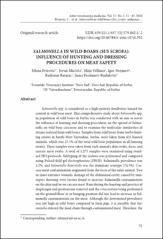| dc.contributor.author | Petrović, Jelena | |
| dc.contributor.author | Mirčeta, Jovan | |
| dc.contributor.author | Velhner, Maja | |
| dc.contributor.author | Stojanov, Igor | |
| dc.contributor.author | Ratajac, Radomir | |
| dc.contributor.author | Prodanov-Radulović, Jasna | |
| dc.date.accessioned | 2024-07-01T09:41:53Z | |
| dc.date.available | 2024-07-01T09:41:53Z | |
| dc.date.issued | 2024-06 | |
| dc.identifier.issn | 1820-9955 | |
| dc.identifier.uri | https://repo.niv.ns.ac.rs/xmlui/handle/123456789/833 | |
| dc.description.abstract | Salmonella spp. is considered as a high-priority foodborne hazard for
control in wild boar meat. This comprehensive study about Salmonella spp.
in population of wild boars in Serbia was conducted with an aim to assess
the influence of hunting and dressing procedures on the spread of Salmonella
on wild boar carcasses and to examine the molecular similarities of
strains isolated from wild boars. Samples from wild boars from twelve hunting
estates in South-West Vojvodina, Serbia, were taken from 425 hunted
animals, which was 25.3% of the total wild boar population in all hunting
estates. Three samples were taken from each animal’s skin swabs, feces, and
carcass meat swabs. A total of 1,275 samples were examined using standard
ISO protocols. Subtyping of the isolates was performed and compared
using Pulsed-field gel electrophoresis (PFGE). Salmonella prevalence was
4.2%, and Salmonella Enteritidis was the dominant serotype (74.5%). Carcass
meat contamination originated from the feces of the same animal. Two
or more entrance wounds, damage of the abdominal cavity caused by nonexpert
shooting were factors found to increase Salmonella contamination
on the skin and/or on carcass meat. Rain during the hunting and practice of
diaphragm and peritoneum removal and the evisceration being performed
on the ground/floor or in hanging position did not lead to increase in Salmonella
contamination on the meat. Although the determined prevalence
was not high in wild boars compared to farm pigs, it is possible that Salmonella
entered the food chain through contaminated meat. Therefore, theimportance of good hunting and hygiene practice in handling and dressing
wild boar carcasses should not be underestimated. | en_US |
| dc.description.sponsorship | This study was funded by the Provincial Secretariat for Higher Education and Scientific Research, Autonomous Province of Vojvodina, contract number: 142-451-3483/2023-01/1. | en_US |
| dc.language.iso | en | en_US |
| dc.publisher | Naučni institut za veterinarstvo Novi Sad | en_US |
| dc.source | Arhiv veterinarske medicine / Archives of veterinary medicine | en_US |
| dc.subject | wild boar | en_US |
| dc.subject | Salmonella | en_US |
| dc.subject | process hygiene | en_US |
| dc.subject | game meat | en_US |
| dc.subject | hunting procedures | en_US |
| dc.title | Salmonella in wild boars (sus scrofa): influence of hunting and dressing procedures on meat safety | en_US |
| dc.title.alternative | Salmonella kod divljih svinja (sus scrofa): uticaj procedura lova i obrade na bezbednost mesa | en_US |
| dc.type | Article | en_US |
| dc.citation.volume | 17 | en_US |
| dc.citation.issue | 1 | en_US |
| dc.citation.spage | 51 | en_US |
| dc.citation.epage | 67 | en_US |
| dc.citation.rank | M24 | en_US |
| dc.type.version | published | en_US |

